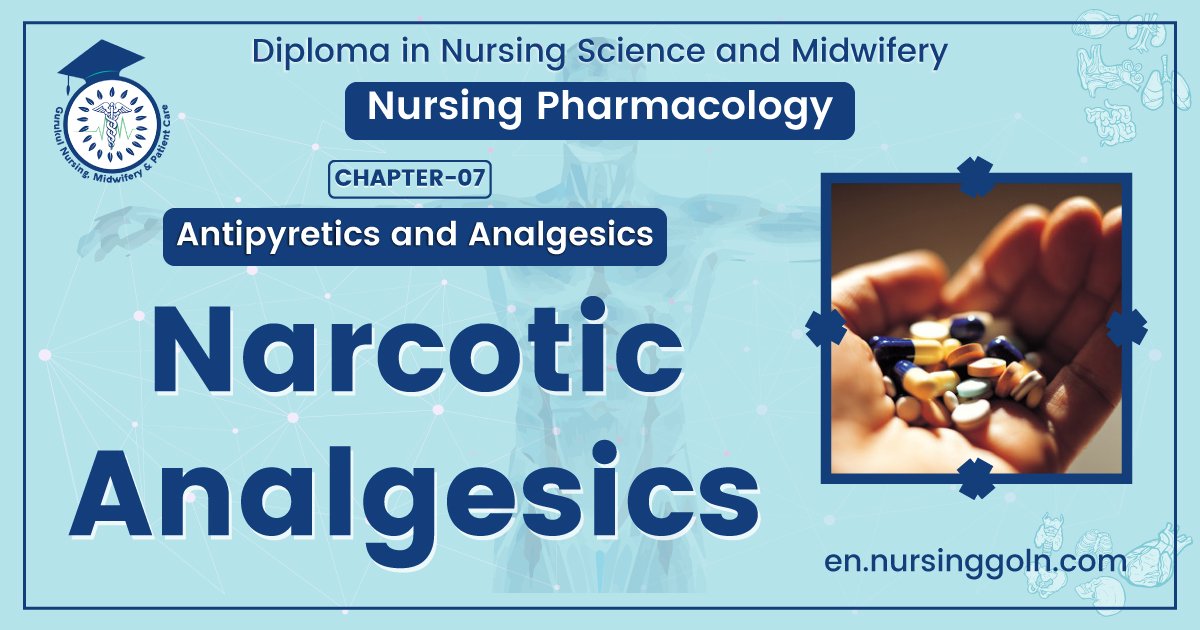Narcotic Analgesics -This book covers the entire syllabus of “Pharmacology” prescribed by BNMC- for a diploma in nursing science & midwifery students. We tried to accommodate the latest information and topics. This book is an examination set up according to the teachers’ lectures and examination questions.
At the end of the book, previous questions are given. We hope in touch with the book students’ knowledge will be upgraded and flourish. The unique way of presentation may make your reading of the book a pleasurable experience.
Narcotic Analgesics
Drugs that induce drowsiness, sleep or stupor, especially with analgesia are called narcotic analgesics.

Classification of Narcotic analgesics
Natural: (opium alkaloids)
1. Morphine
2. Codeine
3. Thebaine Semi-synthetic opiates
4. Morphine
5. Hydromorphine
6. Apomorphine
7. Oxycodone
8. Hydrocodone
9. Heroine
Synthetic analgesics
A. Mepredine and related phenyl-piperidine:
1. Pethidine(meperidine)
2. a- prodine
3. Piminodine
B. Methadone & related drugs:
1. Methadone
2. Propoxyphene

B. Benzomorphanes:
1. Phenazocinc
2. Pentazocine
C. Morphinan derivatives:
D. Narcotic antagonist:
1. Nalorphinc
2. Naloxone
3. Levorpheine
Opium Alkaloids
The word opium is derived from Greek word ‘opion’ meaning Poppy juice. Opium is derived from the dried or partly dried latex by incision from the unripe capsules of papaver somniferum (opium poppy). It has a bitter taste. Opium contains a variable mixture of more than twenty five (25) alkaloids. And the derivatives of opium alkaloid are called opiates.
Classification of by analgesic efficacy
| Low efficacy for mild & moderate pain | High efficacy for Severe pain |
| Codeine Dihydrocodeine Pentazocine (partial agonist) Dextropropoxyphene | Morphine Pethidine Diamorphine Methadone Phenazocine |
Opiates Receptors
The main pharmacological effects of opiates are mediated by Three main types of receptors: u= mu delta k kappa
a 4th subtype. (sigma) we also postulated in order to account for the “dysphoric” effects (anxiety, hallucinations bad dreams etc) produced by some opiates,

Pharmacological effects associated with opioid receptor subtypes:
| Analgesia | Supraspinal or Spinal | Spinal | |
| Respiratory depression | + | + | |
| pupil | Constricted | Dilated | |
| GI motility | Reduced | ||
| Smooth muscle spasm affect | Euphoria | Dysphoria | Dysphoria |
| Physical dependency | + |
Distribution of opioid receptors:
- Dorsal horn of the spinal cord.
- Limbic system
- Peri-aqueductal grey matter
- Substantia gellatenosa
- Spinal trigeminal nuclei
- Nucleus tractus solitaries
- Medial thalamic nuclei
- Nuclei of some vagal response
- Hypothalamic nuclei
Read more:
